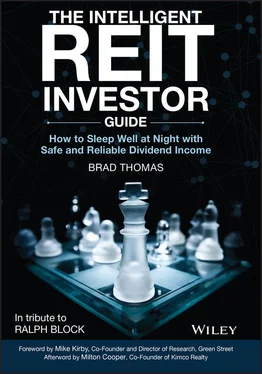The same cannot be said about REITs.
With bonds, what you see is what you get: pure yield and very little else. Take a $10,000 investment in a bond that yields 5% and matures in 10 years. At the end of that decade, you'll have your $10,000 in cash, plus the cumulative amount of interest received (10 × $500) for a total of $15,000.
Now let's say you purchase 1,000 shares of a REIT trading at $10 that offers a 4% yield ($0.40 per share). It also increases its adjusted funds from operations (AFFO) – which, as we'll discuss in more detail later, is a rough approximation of FCF – by 4% annually and its dividend the same amount. The shares then rise in price 4% as well.
Ten years later, the REIT will be paying $0.593 in dividends, and the total investment will be worth $19,812: $4,992 in cumulative dividends received plus $14,820 in share value at that time. That's a difference of $4,812 between the two asset examples, as shown in Table 2.1.
Taxes, of course, will have to be paid on both, cutting into profits on either side. And conventional wisdom says that REITs should provide a higher total return in the end since they're riskier than bonds. However, that's not necessarily true if we consider the bond owner's exposure to inflation. REIT shares offer no specific maturity date, and there's no guarantee of the price you'll get when you sell them. However, bonds have no inflation protection. Their holders are at substantial risk of seeing their purchasing power decline with the dollar.
It's all a question of how one measures risk.
Also, when inflation rises, interest rates historically tend to do the same. This reduces bonds’ market values while they're being held, to the further detriment of anyone who needs to sell them prior to maturity. On the flipside, if interest rates decline enough due to, say, lower inflation, many bonds may be called for redemption before their maturity dates. This deprives investors of what could have otherwise been very attractive yields and forces them to go out hunting again.
Table 2.1REITs Should Produce Better Total Returns than Bonds
| REITs: 4% annual dividend compounded at a 4% annual growth rate |
| End Year |
Stock Price |
Per‐Share Dividend |
| 1 |
$10.40 |
$0.400 |
| 2 |
$10.82 |
$0.443 |
| 3 |
$11.25 |
$0.450 |
| 4 |
$11.70 |
$0.468 |
| 5 |
$12.17 |
$0.487 |
| 6 |
$12.66 |
$0.506 |
| 7 |
$13.17 |
$0.527 |
| 8 |
$13.70 |
$0.548 |
| 9 |
$14.25 |
$0.570 |
| 10 |
$14.82 |
$0.593 |
|
|
$4,992 |
| 1,000 shares |
$14,820 |
$4,992 |
| Total Investment value |
|
$19,812 |
Source: Investing in REITs by Ralph Block.
Admittedly, a REIT's stock price may decline in response to higher interest rates. But interest rates often climb alongside a growing economy, which helps to grow REIT cash flows over time.
For those who want to point out U.S. Treasury bonds as a solution, yes, those aren't callable prior to maturity. And, yes, they entail no repayment risk. But their yields are lower than those of corporate bonds, and they still fluctuate with interest rates regardless.
Bonds are certainly suitable investments for most investors. However, they shouldn't be regarded as good substitutes for REIT stocks in a broadly diversified portfolio. Nor should REIT stocks be seen as good substitutes for bonds.
Comparatively speaking, convertible bonds may provide more competition for REITs. These securities offer comparable yields as well as appreciation potential if the common stock these bonds can be converted into rises substantially.
In general, these assets provide the security of fixed maturity dates in case their underlying common stocks fail to appreciate in value. So they can be relatively attractive investments.
The main problem here is that most companies just don't issue them. Some REITs have occasionally issued convertible securities, including convertible preferred stock. But investors should consider whether the extra safety they provide outweighs the often substantial conversion premium and their relative lack of liquidity.
Many investors seeking higher yields have become interested in preferred stocks, including those issued by REITs. (That's one reason we included an entire segment on preferred shares later in the book.) Unlike bonds, these shares aren't guaranteed by the company in question to repay a specific amount at a specified date. And in the event of liquidation or bankruptcy, preferred shareholders’ rights are subordinated to those of the corporation's creditors.
With that said, they do have seniority over common shareholders. Plus, most preferred stocks specify that common dividends cannot be paid unless preferred dividends are current.
Credit agencies treat preferred stocks as equity when everything is said and done. As for the companies themselves, they regard them as permanent capital that doesn't dilute common‐stock‐related interests, which sounds about right.
Most preferred dividend rates are set when they're first issued and remain that way for as long as the shares are outstanding. And since they have little if any appreciation potential on their own, their holders don't participate in the company's earnings growth. It's also important to know that the issuer can typically redeem them after a period of time – usually five years after issuance – at their original price. So if interest rates fall, the shareholder may be deprived of a good, high‐yielding investment.
Then there's liquidity. It can be difficult to buy or sell large amounts of preferreds at a time. And there's often a significant spread between the bid and ask prices. Additionally, in admittedly abnormal cases where the issuer is acquired or goes private, preferred shareholders can be negatively affected by lack of disclosure concerning company information or by higher debt leverage at the newly private company.
These assets still appeal to many though because of their higher dividend yields compared to most common shares and corporate bonds (assuming comparable credit quality). This, alongside their payouts having priority over common stocks, makes them especially attractive during uncertain times, such as the 2020 pandemic.
Other High‐Yielding Equities
Two better REIT comparisons to make include higher dividend‐yielding publicly traded entities such as utilities and master limited partnerships (MLPs). Utility stocks, for one, have been a long‐standing and reliable staple of the investment world. The industry's total market cap is in excess of $1 trillion, and the top 20 utility stocks have a combined value of $775 billion.
These businesses provide basic services such as electricity, natural gas, water, and wireline telephony to individuals and businesses. Competition isn't practical in most of these areas, allowing many of them to form what amounts to legal monopolies.
This is both good and bad for their shareholders. On the one hand, the utility doesn't have to compete with other providers, so its earnings and dividends are often quite stable. On the other, that stability can equate to very, very slow growth: perhaps 2–4% annually. Plus, these entities can only charge customers what the regulatory authorities permit, so they run the risk of fickle and sometimes politically motivated pricing.
In recent years, some utilities have been “unbundled,” as it were. Those that generate or purchase power, and sell it to other service providers, for example, have become much less regulated. So their growth prospects are now better. Then again, their earnings are much less certain, and their dividend yields tend to be much lower.
Читать дальше












